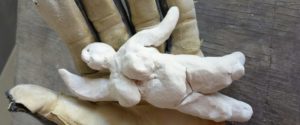Home » Carve » Experience » Getting Started » Art and Sculpture – Drawing Can Help Us Sculpt
For those born without the innate gift to draw well, acquiring an artist’s skill seems undoable. “Not so,” said Bob Leverich in the summer of 2008 in a lecture at Camp Brotherhood. “It just takes a lot of practice.” Seven and a half years after the lecture itself, I typed up my notes from Bob’s lecture. Here they are, with some thoughts of my own.
Should you care how to draw? Although clients may want to see sketches of a proposed commission, the most important reason to learn how to draw (as Alexandra Morosco emphasized to me when she saw my second sculpture in 2003) is to learn how to see.
Learning how to draw. There is no one “secret,” other than a lot of practice, preferably with a live model. But there are a few insights that are important. Here is one, not from Bob, but from Visual Thinking, by Rudolf Arnheim: for the survival of our species, it was “of the greatest practical importance that things should be seen as constant and that change should be attributed to them only when they themselves do the changing.” In other words, the instinctive rejection of proportion as presented to us by our eyes is a survival skill. That made me feel better: I’m not so much a bad drawer as a good survivor. “Un-seeing” that rejection – one of the requirements for drawing well – takes a lot of training.
How does one do that? Bob recommended one solution:
see how the Masters solved the problem. Not just perspective: how does Degas solve the problem of showing the volume of the cheek? How did Monet organize the page? To find out, trace the work. “No, this is not copying,” Bob said. Well, of course it is copying, but the point is that it isn’t copying for the sake of shilling it out to unsuspecting buyers, but copying in order to learn.
Pay attention to the stages of drawing. The first stage is wanting to draw a particular thing – a tree, perhaps, or a beautiful woman – or man. Once one achieves a rudimentary understanding, the next stage is paying attention to the object you are drawing, versus the field in which the object lies, so that you begin to draw fields rather than objects.
Relationships. “Everything,” Bob says, “is relationships in a painting:” pay attention to the relationships amongst the objects you’re drawing.
Keep track of your ideas. Mark Twain once said something like, “If I’d written down all the ideas for novels I ever had, I would have been the greatest novelist of all time.” So Bob recommended that you write down your art ideas. Because if you don’t, you’ll lose them. He also recommended keeping an art notebook/journal with you. Write in it, Bob said. Draw in it. The drawing is for you. The drawings are about insight, not skill. And the writing in the notebook is so that you can have a dialogue with yourself. And so that you can have a way to get the idea down to remind yourself later.
Then, over time, you have lots of sketchbooks, and things emerge. “Oh, I’ve been thinking of this for a while.” I saw that personally just this past week. I’ve had a recurring image about which I’ve been thinking a lot. I recently reread a writing journal from six years ago: there is it was! I’d been thinking about that idea all this time. Sounds like I need to start sculpting it.
Don’t worry about being original in writing in your journal; rather, find out “what is yours.” Originality isn’t the same thing as novelty. You are looking for your roots; to see what keeps reappearing.
Be wary of throwing out drawings you hate. I have little respect for my two-dimensional abilities, but when I go back over old work, every now and again I say “Hey! That wasn’t too bad.” Conversely, sometimes I’m feeling bad that I’m not a better artist, and then I’ll see something I did long ago that truly sucks, and I’ll realize I have come a long way. You won’t be able to make those comparisons if you’ve tossed your old work. In the last week I drew from a bust the head of Michelangelo’s David, and then compared it to my 2006 drawing of the same head. Yes, my 2015 drawing was much better. Whew!
Symbolism in sculpture. Bob quoted Matisse, “The measure of an artist is the number of plastic (that is, malleable/shapeable) symbols he has introduced into the language of art.’ Some fine sculptors scoff at this notion as it applies to sculpture, but if meaning in art is important for you, then you should think about what “plastic” symbols you are bringing to your work.
Fear. Bob’s suggested that you think about what stops you, about what shuts you down from drawing – or from sculpting. For me, it is fear of being a beginner, of not being good enough.
Here in another approach for dealing with it. A friend of mine recently wrote of having seen a movie documentary about Seymour Bernstein, a concert pianist who gave up his career to teach. A former student talked about feeling inadequate, to which Seymour replied: “Well, stop beefing about it and make yourself adequate.”
Permission. I have a project to do in my garage (This is me talking, not Bob). It would be a fun project – mildly naughty, perhaps, but fun. It’s been there awaiting me, undone, for a year. In the last 365 days, all of us have had time to do about anything. So why haven’t I done it? The Protestant Ethic, perhaps: it is frivolous. It won’t sell. No gallery owner will be impressed. The real reason, then? I didn’t give myself “permission.” Don’t be like me: give yourself permission to be a beginner, permission to do things that won’t pay the rent, permission to, in short, have fun.
Scheduling time to draw is important. As an example, I’ve set out below my personal log of a recent drawing project – generalized for your benefit – for which I’d scheduled one hour.



We need some kind of descriptive text here.